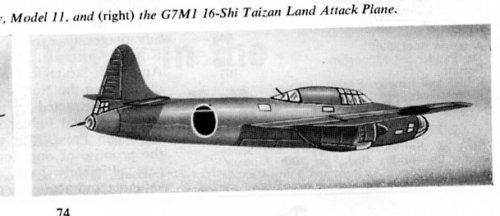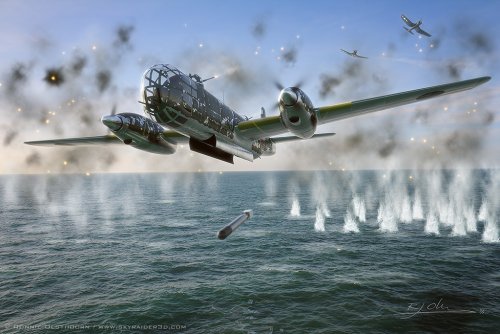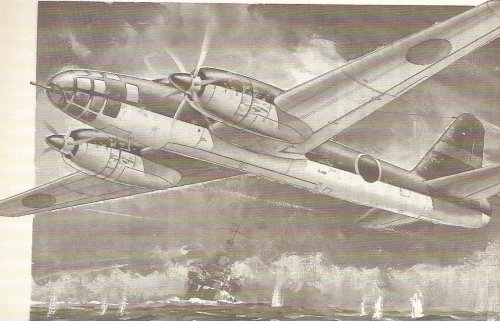You are using an out of date browser. It may not display this or other websites correctly.
You should upgrade or use an alternative browser.
You should upgrade or use an alternative browser.
Mitsubishi G7M Taizan
- Thread starter T-50
- Start date
Pelzig
ACCESS: Secret
- Joined
- 23 October 2008
- Messages
- 448
- Reaction score
- 74
The drawing here comes from a issue of Air Pictorial. It shows the G7M as designed by Kiro Honjo. There was a version designed first, however, by Kijiro Takahashi which was quite different from what Honjo came up with (which, basically, was a derivative of the G4M which he also worked on). Takahashi's design used two 24-cylinder, H-engines and had a nose not unlike the Heinkel He 177 (among other similar features) and used a tricycle landing gear system. The design was doomed when the needed machinery to produce the H-engines could not be imported. With Takahashi's project shelved, Honjo took over but, ultimately, even the G7M (and its competitor, the Kawanishi K-100) was canceled in favor of four-engined bomber designs.
As a note, the G7M was intended as a long range, strategic bomber, not a medium bomber like the G4M (despite its great range). In the end, the constant revisions to the G7M resulted in a design little better than the G4M which helped speed its demise.
Cheers,
Ed
As a note, the G7M was intended as a long range, strategic bomber, not a medium bomber like the G4M (despite its great range). In the end, the constant revisions to the G7M resulted in a design little better than the G4M which helped speed its demise.
Cheers,
Ed
T-50 said:Hello folks im looking for drawnings/artist impressions of the Mitsubishi G7M Taizan
It was mend as the follow up of the Mitsubishi G4M Rikko(Betty) ,it was a two engined medium
bomber like the Rikko.
greetings T-50
Attachments
Pelzig
ACCESS: Secret
- Joined
- 23 October 2008
- Messages
- 448
- Reaction score
- 74
Takahashi's design, with a lighter payload, was expected to meet the 4,598 mile range dictated by the 16-shi specification. The Dornier Do 17 couldn't even touch this kind of range. For reference, from Tokyo, Japan to Los Angeles, California is 5,478 miles.
With Takahashi's version of the G7M doomed, Honjo's version, while also estimated to be able to attain the 16-shi range, was wishful thinking. No doubt the Kaigun Koku Hombu realized to attain such a range would have resulted in a relatively worthless bomb load.
The G7M was a strategic bomber, not a heavy bomber. By strategic, we are talking about a plane capable of a very large operational radius.
Cheers,
Ed
With Takahashi's version of the G7M doomed, Honjo's version, while also estimated to be able to attain the 16-shi range, was wishful thinking. No doubt the Kaigun Koku Hombu realized to attain such a range would have resulted in a relatively worthless bomb load.
The G7M was a strategic bomber, not a heavy bomber. By strategic, we are talking about a plane capable of a very large operational radius.
Cheers,
Ed
T-50 said:Hi Ed thanks for the drawning, it looks a lot like the Betty
I didnt know that the G7M was an long range heavy bomber,i thougt becouse its size it was an
medium bomber like the G4M or Dornier D-17
cheers T-50
This is an interesting piece of information Ed.
When I saw the first illustration of the Taizan with the He-177 noselook
compared with Shorzu Abe's illustration in Air Pictorial
I was almost convinced that the former was largely a fake design.
(maybe due to the very large wingroots).
Your explantion cleans up the picture... Thanks.
When I saw the first illustration of the Taizan with the He-177 noselook
compared with Shorzu Abe's illustration in Air Pictorial
I was almost convinced that the former was largely a fake design.
(maybe due to the very large wingroots).
Your explantion cleans up the picture... Thanks.
Pelzig
ACCESS: Secret
- Joined
- 23 October 2008
- Messages
- 448
- Reaction score
- 74
Honjo's original concept for the G7M had four engines but just the mere suggestion of using four engines saw Honjo's idea squashed by the Kaigun Koku Hombu before it ever got anywhere. This is when Takahashi stepped up with his two engine design. It wasn't until the failure of the G7M1 (Honjo's two-engine design) and the K-100 to meet the 16-shi and 17-shi specifications respectively did the Kaigun Koku Hombu become more receptive to four engine bombers. Of course, by then, it was too little, too late.
airman said:usually as project , was an heavy bomber with two engine , other elements on web, make suppose there was also a version of project with four engines !
Hi airman the version depicted on the site you mentioned has very modern looking nacelles.airman said:http://forum.valka.cz/viewtopic.php/title/Micubisi-G7M1/t/66000
here ! ::

actually they seems to me turboprops,I know the Japanese were developing jet engine's like Germany and the UK
I know also the Germans were working on a turboprop engine (Junkers) were the Japanese also working on similar projects?
cheers T-50
Pelzig
ACCESS: Secret
- Joined
- 23 October 2008
- Messages
- 448
- Reaction score
- 74
The image of the G7M shown in the link Airman provided is Takahashi's version. The Japanese were investigating turboprops but the G7M as envisioned by Takahashi did not use them despite what the image may infer.
Cheers,
Ed
Cheers,
Ed
T-50 said:Hi airman the version depicted on the site you mentioned has very modern looking nacelles.airman said:http://forum.valka.cz/viewtopic.php/title/Micubisi-G7M1/t/66000
here ! ::

actually they seems to me turboprops,I know the Japanese were developing jet engine's like Germany and the UK
I know also the Germans were working on a turboprop engine (Junkers) were the Japanese also working on similar projects?
cheers T-50
Hi Ed thanks for the info, I found it strange a Japanese bomber with turbo props.
although they were developing these kind of engines,it was to premature to equipping
this aircraft with turboprops.normal engines looks for me more logical.
cheers T-50
although they were developing these kind of engines,it was to premature to equipping
this aircraft with turboprops.normal engines looks for me more logical.
cheers T-50
Boogey
B'Boomelang
- Joined
- 10 February 2009
- Messages
- 200
- Reaction score
- 35
And here's another 3-view draft of Mitsubishi G7M-1 Taizan, similar to these from forum.valka
given by airman
Mine is taken from Tadeusz Januszewski & Krzysztof Zalewski's " Japońskie Samoloty Marynarki 1912 - 1945 "
t. 2, p. 79 ( as I don't have a scaner, it's only a photo of the page ).
given by airman
Mine is taken from Tadeusz Januszewski & Krzysztof Zalewski's " Japońskie Samoloty Marynarki 1912 - 1945 "
t. 2, p. 79 ( as I don't have a scaner, it's only a photo of the page ).
Attachments
- Joined
- 26 May 2006
- Messages
- 33,222
- Reaction score
- 13,066
Attachments
- Joined
- 11 March 2006
- Messages
- 8,648
- Reaction score
- 3,393
Triton said:Artist's impression of Mitsubishi G7M "Taizan" by Ronnie "Skyraider3D" Olsthoorn.
Source:
http://www.military-meshes.com/forums/showthread.php?t=4171
I just hope, the artist was paid twice, even when his work was just mirrored and principally is exactly
the same as used by unicraft ! :-\
Attachments
blackkite
Don't laugh, don't cry, don't even curse, but.....
- Joined
- 31 May 2007
- Messages
- 8,489
- Reaction score
- 6,582
;DJemiba said:Triton said:Artist's impression of Mitsubishi G7M "Taizan" by Ronnie "Skyraider3D" Olsthoorn.
Source:
http://www.military-meshes.com/forums/showthread.php?t=4171
I just hope, the artist was paid twice, even when his work was just mirrored and principally is exactly
the same as used by unicraft ! :-\
I think engine cooling air inlet area is extremely small, nevertheless forced air cooling radial engine.
And vertical stabilizer area is little small for long nose and long engine nacelle.
Where is engine cowl flap?
Attachments
- Joined
- 11 March 2006
- Messages
- 8,648
- Reaction score
- 3,393
[quote author=blackkite]
I think engine cooling air inlet area is extremely small, nevertheless forced air cooling radial engine.
And vertical stabilizer area is little small for long nose and long engine nacelle.
Where is engine cowl flap?
[/quote]
Indeed ! I've the feeling, that the wing in the 3-view is thicker, than in the artist impression, so maybe
the radiators were integrated into the leading edge, as in the DH Mosquito ? THe aircraft somewhat looks
like a scaled down He 177.
I think engine cooling air inlet area is extremely small, nevertheless forced air cooling radial engine.
And vertical stabilizer area is little small for long nose and long engine nacelle.
Where is engine cowl flap?
[/quote]
Indeed ! I've the feeling, that the wing in the 3-view is thicker, than in the artist impression, so maybe
the radiators were integrated into the leading edge, as in the DH Mosquito ? THe aircraft somewhat looks
like a scaled down He 177.
blackkite
Don't laugh, don't cry, don't even curse, but.....
- Joined
- 31 May 2007
- Messages
- 8,489
- Reaction score
- 6,582
May be this 3-side view and artistic impression represent some important facts.
For example nose shape and strong armaments.
I want to know the original source of these surprising drawings.
For example nose shape and strong armaments.
I want to know the original source of these surprising drawings.
blackkite
Don't laugh, don't cry, don't even curse, but.....
- Joined
- 31 May 2007
- Messages
- 8,489
- Reaction score
- 6,582
Hi Jens! Thank you.
Of course I have this great book, already checked G7M taizan and got some important informations.
I'm trying to get another useful "Maru(丸)" magazine. I can inform you some topics about Taizan.
Please wait.
Of course I have this great book, already checked G7M taizan and got some important informations.
I'm trying to get another useful "Maru(丸)" magazine. I can inform you some topics about Taizan.
Please wait.
blackkite
Don't laugh, don't cry, don't even curse, but.....
- Joined
- 31 May 2007
- Messages
- 8,489
- Reaction score
- 6,582
blackkite
Don't laugh, don't cry, don't even curse, but.....
- Joined
- 31 May 2007
- Messages
- 8,489
- Reaction score
- 6,582
Hi my dear lark! Perhaps your opinion is correct.lark said:Perhaps it's good to mention that there were
two Taizan concepts.
The other one had a strong resemblence to the Mitsubishi 'Betty'..
Former Taizan concept had liquid cooling H24 shape ME2A engine with skin cooler and refer to He177.
The fuselage was slim and the armament were light.
Source : Maru(丸) magazine in January 2012.(No.789)
- Joined
- 11 March 2006
- Messages
- 8,648
- Reaction score
- 3,393
blackkite said:Almost same shape of Mitsubishi Ki-67 Hiryu.
Was my first thought, too, but what appears to be a stepped cockpit, as in the Ki-67, may
be the forward gunners station.
blackkite
Don't laugh, don't cry, don't even curse, but.....
- Joined
- 31 May 2007
- Messages
- 8,489
- Reaction score
- 6,582
Yes it is. Same as Ki-67.Jemiba said:blackkite said:Almost same shape of Mitsubishi Ki-67 Hiryu.
Was my first thought, too, but what appears to be a stepped cockpit, as in the Ki-67, may
be the forward gunners station.
前方射手:forward gunner, 爆撃手:bombardier
Attachments
windswords
ACCESS: Secret
- Joined
- 19 May 2009
- Messages
- 387
- Reaction score
- 196
Blackkite,
That is a great illustration you posted for us. I am going to call it the "traditional" G7M concept (as opposed to Ed Dyers depiction of a more radical concept). I notice in the drawing it has 6 bladed propellers. Can you confirm that?
That is a great illustration you posted for us. I am going to call it the "traditional" G7M concept (as opposed to Ed Dyers depiction of a more radical concept). I notice in the drawing it has 6 bladed propellers. Can you confirm that?
blackkite
Don't laugh, don't cry, don't even curse, but.....
- Joined
- 31 May 2007
- Messages
- 8,489
- Reaction score
- 6,582
Hi windswords! Very good naming. I will post some topic about radical and traditional Taizan.windswords said:Blackkite,
That is a great illustration you posted for us. I am going to call it the "traditional" G7M concept (as opposed to Ed Dyers depiction of a more radical concept). I notice in the drawing it has 6 bladed propellers. Can you confirm that?
Taizan's story was little complicated one. :-[
blackkite
Don't laugh, don't cry, don't even curse, but.....
- Joined
- 31 May 2007
- Messages
- 8,489
- Reaction score
- 6,582
- Joined
- 11 March 2006
- Messages
- 8,648
- Reaction score
- 3,393
blackkite
Don't laugh, don't cry, don't even curse, but.....
- Joined
- 31 May 2007
- Messages
- 8,489
- Reaction score
- 6,582
windswords
ACCESS: Secret
- Joined
- 19 May 2009
- Messages
- 387
- Reaction score
- 196
windswords
ACCESS: Secret
- Joined
- 19 May 2009
- Messages
- 387
- Reaction score
- 196
It seems that the Q2M is a version of the G7M. It would be logical that the G7M would have been first, G as used in the Japanese Navy designation system means "Attack" bomber. In English we would say a land based bomber. Then as an additional product the Q2M, a patrol/anti-submarine aircraft would be developed. Certainly Mitsubishi would build more G7M's than Q2M's. This would be similar to hte A6M and A6M-N floatplane fighter. It has gone in the other direction of course, the most famous example being the N1K Rex floatplane fighter being developed into the N1K-J Shiden land base fighter. Hopefully Blackkite can shed some light on this. Another giveaway that the two planes are related is that the drawings of the Q2M and what I call the "traditional" concept of the G7M (see my previous comment) both appear to have 6 blade propellers.
Blackkite, if you can find measurements for the two planes length and wingspan it would tell us more. If the two projects are based off the same design then the measurements will be close to each other.
Addendum - I just looked at the illustration of the G7M from Blackkite. It is the mid-wing design. The drawings I have of the Q2M show a low-wing design. That doesn't rule out a relationship completely between them but that is usually something that is not changed when designing variations of the same basic model.
Blackkite, if you can find measurements for the two planes length and wingspan it would tell us more. If the two projects are based off the same design then the measurements will be close to each other.
Addendum - I just looked at the illustration of the G7M from Blackkite. It is the mid-wing design. The drawings I have of the Q2M show a low-wing design. That doesn't rule out a relationship completely between them but that is usually something that is not changed when designing variations of the same basic model.
The G7M seems to be yet another example of the waste created by the WWII era Japanese inter-service rivalry.
If the data the referenced Polish language website is true, the G7M was a slightly larger slightly heavier version of of the Ki-67. (about 10% larger for both measures). Same engines, same contours (at least the second version).
If reason had prevalled, the two services would have shared a single airframe.
If the data the referenced Polish language website is true, the G7M was a slightly larger slightly heavier version of of the Ki-67. (about 10% larger for both measures). Same engines, same contours (at least the second version).
If reason had prevalled, the two services would have shared a single airframe.
Similar threads
-
-
-
IJN Service Airplane Development Program Designations
- Started by snark
- Replies: 7
-
IJNAF Rikkos- asset or resource waste?
- Started by lancer21
- Replies: 4
-
Japanese Secret Projects:Experimental Aircraft of the IJA & IJN 1939-1945
- Started by Pelzig
- Replies: 261
















